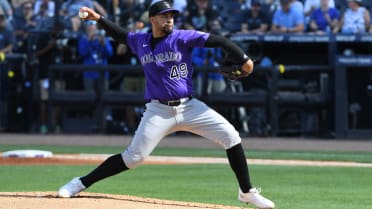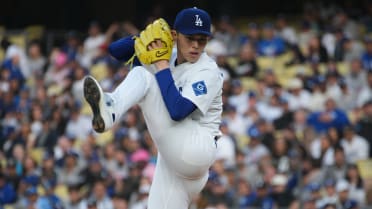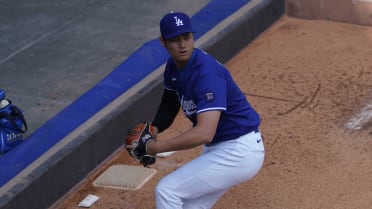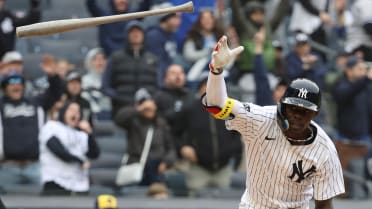SAN DIEGO -- The 1998 Padres -- who cruised to a division title and dethroned two 100-win juggernauts to capture the National League pennant -- are revered as the greatest team in franchise history.
Naturally, Padres fans are well versed in October 1998 -- from Kevin Brown's gem against Randy Johnson, to key homers from Jim Leyritz and Ken Caminiti; from Tony Gwynn's World Series blast at Yankee Stadium, to Mark Langston’s strike-that-wasn't to Tino Martinez.
But the story doesn't begin in October. This is the story of the 1998 Padres, told through 14 memorable games from an unforgettable season:
March 31, Cinergy Field, Cincinnati
Padres 10, Reds 2
Record: 1-0, T-1st in NL West
Known as a gunslinger, general manager Kevin Towers lived up to his nickname during the 1997-98 offseason. The Padres were coming off a last-place finish with a number of important pieces whose contracts were set to expire after the season. Towers rolled the dice anyway.
In December, Towers traded Derrek Lee -- the Padres' presumed future at first base -- to Florida in exchange for Brown, who was entering the final year of his contract. The risk was clear, but Brown was an ace in his prime.
"We got one of the top two or three pitchers in baseball," Towers said at the time. "He'll be the guy at the top of our rotation."
Brown fit into that role from the start, tossing 6 1/3 innings of one-run ball as the Padres cruised to an Opening Day victory in Cincinnati -- a harbinger of what was to come.
April 10, Qualcomm Stadium, San Diego
Padres 6, D-backs 4
Record: 8-2, 2-game lead in NL West
Brown had a rare off night in his third start, allowing four runs over seven innings before exiting with the Padres trailing, 4-2.
"You have your ace on the mound, facing the Diamondbacks, an expansion franchise," Steve Finley recalled. "We knew that's a game we should've won."
Finley made it happen. With two outs and the bases loaded, D-backs right-hander Felix Rodriguez grooved a thigh-high fastball, and Finley sent it soaring into the right-field seats.
"That really set up a feeling for our team," said Mark Sweeney, who walked earlier in the frame. "That type of victory has meaning down the line. It snowballed."
April 28, Qualcomm Stadium, San Diego
Padres 7, Cubs 3
Record: 18-7, 4 1/2-game lead in NL West
Gwynn entered the season coming off four straight batting titles -- all with an average above .350. By those impossibly lofty standards, ’98 was a down year for Gwynn, who battled a balky knee and was limited to 127 games.
But how’s this for a down year? Gwynn still batted .321 with 16 homers, and he came through when it mattered. Gwynn batted .472 with two outs and men in scoring position and .358 in late-and-close situations.
"You needed a big hit, Tony got it for you," said Finley. (Sure enough, Gwynn would bat .500 in the World Series.)
Facing the Cubs in late April, Gwynn helped propel the Padres 4 1/2 games up on the Giants in the NL West with his ninth and final five-hit game. Only Ty Cobb and Pete Rose have more.
June 17, Qualcomm Stadium, San Diego
Padres 3, Dodgers 2, 12 innings
Record: 46-25, 3 1/2-game lead in NL West
Despite their hot start, the Padres weren't wire-to-wire division winners in 1998. They slumped in May and fell a game behind the Giants in early June. A critical homestand loomed.
That's when the Padres turned it on. They swept the Reds, swept the Giants and were on the verge of sweeping the Dodgers in a wild back-and-forth affair that went 12 innings.
After a rare two-inning appearance from Trevor Hoffman, Greg Vaughn singled to start the 12th. Then Wally Joyner looped a routine single up the middle. The ball took a strange kick past Dodgers center fielder Roger Cedeno, and Vaughn skipped around third as the winning run.
"We just had trust in each other, and we had a really complete team,” Finley said. “We just knew we were going to win those kinds of games."
July 12, Dodger Stadium, Los Angeles
Padres 6, Dodgers 3
Record: 59-33, 7-game lead in NL West
In the final year of his contract, Caminiti played the 1998 season knowing it might be his last in San Diego. He got off to a slow start, but by the time July rolled around, Caminiti was, well, Caminiti.
Facing Dodgers left-hander Brian Bohanon, Caminiti homered in the first and third innings from the right side. In the eighth, he turned to the left side to face Antonio Osuna. Caminiti looped an opposite-field fly ball that cleared the left-field wall at Dodger Stadium. He became just the third player in franchise history to hit three homers in a game, and the first to do so with blasts from both sides of the plate.
"When Cammy was hot, it was just different," Sweeney said. "With Tony, it was consistency. But with a guy like Cammy, maybe it wasn't his '96 MVP year ... but when he went on those hot stretches, it just gave us a different attitude."
July 25, Qualcomm Stadium, San Diego
Padres 6, Astros 5
Record: 68-36, 13-game lead in NL West
Finley spent 1989 with Baltimore, where closer Gregg Olson entered games to "Wild Thing" as a tribute to the movie “Major League.” With Hoffman emerging as one of the sport’s best closers, Finley approached Charles Steinberg, the Padres VP of marketing.
"We need something for Trevor," Finley said.
Hoffman had converted 40 straight saves, one shy of tying the Major League record. When he emerged from the bullpen on July 25 into a one-run game, AC/DC's "Hells Bells" blared for the first time.
Hoffman struck out Moises Alou to tie the record, but the day is remembered mostly as the day "Hells Bells" and Hoffman became intertwined -- a Hall of Fame-caliber closer with Hall of Fame-caliber entrance music.
"It happened pretty fast," Hoffman said. "I didn't know what Fins was doing behind the scenes. ... I don't know if anyone thought it would blow up as big as it did. But I knew it was pretty cool right away. Hearing that first bell kind of knocked me off the [bullpen] mound."
Aug. 5, Qualcomm Stadium, San Diego
Padres 4, Phillies 0
Record: 74-40, 12-game lead in NL West
How good was 1998 Kevin Brown? Well, Brown reeled off a streak in which he won 11 consecutive decisions, tying a franchise record -- and his ERA actually went up. Brown completed that remarkable streak by outdueling Curt Schilling in early August. He pitched a shutout, striking out 11 Phillies.
By then, it was clear Towers' decision had paid off. Brown would become arguably the greatest one-year rental in baseball history. Since the advent of free agency, no player has posted a higher WAR than Brown's 8.6 mark in his only season with a club.
More than that, however, Brown was the missing piece in an already strong rotation featuring Andy Ashby, Joey Hamilton, Sterling Hitchcock and Langston.
"It's like having Trevor Hoffman at the end of the bullpen," Finley recalled. "It helps everybody else align themselves into a set role. Kevin Brown was our ace, and the rest of our rotation filled in behind him."
Said Hoffman: "You have a bona fide ace come in, let those guys slide into the 2-3 spot, and he takes the reins. His impact and his presence just gave us so much confidence."
Brown finished with a 2.38 ERA and a franchise-record 257 strikeouts. It's the best pitching season in team history. Hoffman, meanwhile, posted a 1.48 ERA and tied a then-NL record with 53 saves -- the best relief season in team history. The duo shared Cy Young votes, denying each other a shot at the award. (They finished second and third to Atlanta's Tom Glavine but would get their revenge in October.)
Aug. 7, Qualcomm Stadium, San Diego
Padres 6, Marlins 3, 13 innings
Record: 75-41, 13-game lead in NL West
After catching 13 grueling innings, it was Carlos Hernandez who stepped to the plate with two men aboard and the Padres in search of their eighth walk-off win of the season.
"Couldn't ask for a better teammate," Hoffman recalled of Hernandez. "He was as loyal as loyal comes, took so much pride in the defensive side of his game for his pitchers. He could handle Brownie's 97 mph sinker, then that parachute changeup he'd get in a few innings from me.
"And he never got cheated at the plate either."
Hernandez sent a towering three-run homer into the left-field seats and punctuated the victory with a shout and a bat flip. The Padres were cruising to a division title.
Sept. 12, Qualcomm Stadium, San Diego
Padres 8, Dodgers 7
Record: 94-55, clinched NL West
By mid-September, the division was a foregone conclusion. But the Padres still managed to clinch in dramatic fashion. In front of 60,823 at a sold-out Qualcomm Stadium, the Dodgers jumped out to a 7-0 lead. But the Padres clawed their way back, punctuating a five-run sixth-inning rally with Quilvio Veras' game-tying sac fly and Vaughn's go-ahead single.
"It was just typical of how we felt as a club," Sweeney said. "We just always felt we could come back."
Hoffman whiffed Matt Luke to end the game, and the party was on. It spilled from the clubhouse onto the field, where the Padres celebrated with thousands of fans who remained.
"That was an exclamation point on the season," Finley recalled. "A storybook way to win it."
In an on-field interview after the game, Gwynn put it succinctly:
"The character of this club showed through again," he said. "We battle back."
Sept. 27, Bank One Ballpark, Phoenix
Padres 3, D-backs 2
Record: 98-64, first place in NL West by 9 games
In a stretch that's mostly forgotten to history, the Padres floundered after clinching the division. They went 3-9 over their next 12 games, ending Hoffman's chase for the single-season saves record and any chance at a 100-win season.
"It was just bad baseball," Sweeney recalled, adding that manager Bruce Bochy called a meeting before the final series in Arizona, exuding calmness despite the struggles.
On the field, one mark was still within reach: Vaughn's chase for the first 50-homer season in franchise history. For 13 days, Vaughn sat on 49, until his final at-bat of the season. With the score tied at 1 in the eighth, he sent a laser down the left-field line.
"I remember it like I hit it," Sweeney said. "He meant that much to us. It cleared the fence, and we all went crazy, and it almost felt like we were a college team. It gave us a breath of fresh air when he accomplished that, and we all exhaled."
Fittingly, Hoffman pitched a 1-2-3 ninth, putting the perfect cap on the most prolific regular season in Padres history. A drama-filled October lay ahead.
Sept. 29, Astrodome, Houston
Padres 2, Astros 1
Game 1, NLDS
As pitchers' duels go, this is as good as it gets. Peak Randy Johnson facing peak Kevin Brown with serious postseason stakes. The two aces matched zeroes for five innings, before Leyritz put the Padres on top with a sacrifice fly in the sixth (plating Gwynn, who'd led off the frame with a double against Johnson).
That was all the support Brown would need. He authored one of the definitive postseason pitching performances of all time, striking out 16 Astros -- a lineup that included future Hall of Famers Jeff Bagwell and Craig Biggio, along with four other All-Stars.
Brown's 16 strikeouts are still the most in a Division Series game, and he would come one punchout shy of tying Bob Gibson's longstanding playoff record of 17 K's. In the ninth, Bochy instead called for Hoffman -- who allowed a run, but picked up the save.
Prior to the game, Towers had famously noted: ''I will take Kevin Brown head-to-head with Randy Johnson in any game. ... I'll take my chances with Kevin Brown anywhere, I don't care where it's at."
Brown would prove his GM correct, rather emphatically.
Oct. 7, Turner Field, Atlanta
Padres 3, Braves 2 (10 innings)
Game 1, NLCS
Things wouldn't get any easier for the Padres after knocking off the 102-win Astros in four games in the NLDS. The juggernaut Atlanta Braves were up next, on the heels of their 106-win season (and a decade in which they'd already captured four pennants). But the Padres were up for the challenge from the start.
Game 1 offered yet another pitchers' duel, this one between Ashby and John Smoltz. Ashby exited on top, with the Padres leading, 2-1, after seven. Andruw Jones' ninth-inning sacrifice fly saddled Hoffman with a rare blown save, but San Diego had an answer.
Always up for the biggest moments, Caminiti -- in a trademark display of his ridiculous power -- launched an opposite-field blast several rows deep into the Turner Field bleachers. The Padres had made their statement.
Oct. 14, Turner Field, Atlanta
Padres 5, Braves 0
Game 6, NLCS
No doubt, Caminiti's homer was a big one. As was Leyritz's go-ahead blast in Game 4 of the NLDS. But the biggest at-bat of the 1998 Padres season? Here's an all-time unlikely hero: Sterling Hitchcock.
The Padres had lost consecutive games to the Braves, meaning a wholly unwanted trip back to Atlanta for Game 6, where Hitchcock would take the ball opposite Tom Glavine. The two left-handers pitched scoreless ball into the sixth, when Hitchcock -- of all people -- opened the floodgates.
"He was one of the worst hitters I've ever seen," Bochy once quipped. "He put it in play, and good things happened."
Hitchcock came to the plate with the bases loaded in the sixth and fell behind, 0-2, before shooting a blooper into shallow left field. Three runs scored when Danny Bautista dove and couldn't corral it, allowing the ball to skitter away.
"I was definitely never known for my hitting abilities, and that goes back to Little League," Hitchcock said. "It was more luck than anything, but was certainly a big moment."
Three innings later, the Padres were World Series-bound, when Hoffman got Michael Tucker to fly out, sealing San Diego's first NL pennant in 14 years.
Oct. 17, Yankee Stadium, New York
Yankees 9, Padres 6
Game 1, World Series
The Padres were massive underdogs against the 114-win Yankees, widely regarded as one of the greatest teams of all-time. But they didn't see themselves that way. They'd already taken down a pair of heavy favorites in the National League.
San Diego didn't open the World Series playing like an underdog either. With the game tied at two in the fifth inning, Gwynn authored one of the most indelible moments of his legendary career. He turned on a David Wells fastball, sending it off the facing of the upper deck and quieting a raucous Yankee Stadium. Vaughn followed with a homer of his own, and the Padres led, 5-2.
If you've read this far, you probably know the ending -- and it's not a fairytale ending. The Yankees rallied to tie the game at 5 in the seventh inning, but San Diego appeared to have escaped a bases-loaded jam when Langston got Tino Martinez to look at what could have (should have?) been strike three. It wasn't, and Tino Martinez sent the next pitch into the upper deck for a grand slam, propelling the Yankees to a sweep.
In the end, the 1998 Padres captured a postseason berth, a division title, a National League pennant and the best season in franchise history. They came up just short of their ultimate goal.
AJ Cassavell covers the Padres for MLB.com.




